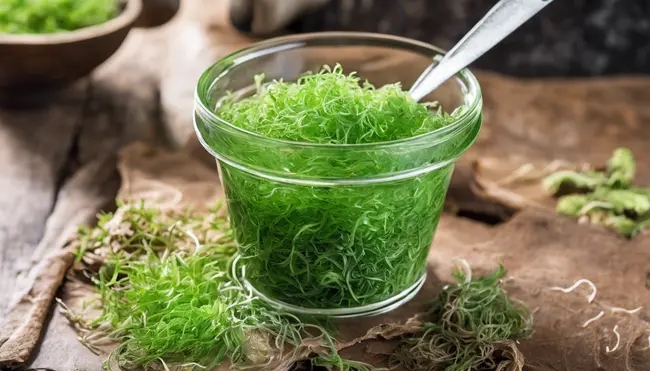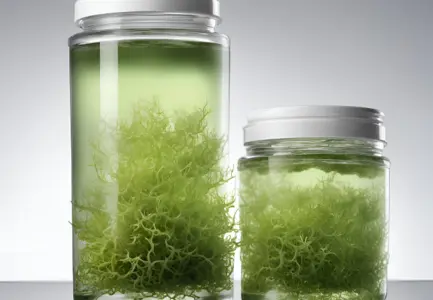How to Make Sea Moss Gel at Home | 15 Pro Step-By-Step Tips

This post may contain affiliate links, meaning I may earn a commission if you make a purchase, at no extra cost to you. I only recommend products I trust. Thank you for your support.
Sea moss gel, a nutrient-dense puree made from seaweed, has gained immense popularity recently as a wellness trend.
Sea moss gel is a nutrient-dense vegan and gluten-free product that provides a variety of essential nutrients and can be a valuable addition to a balanced diet when consumed in appropriate portions.
Derived from Chondrus crispus (also known as Irish moss), this gelatinous substance boasts a texture akin to aloe vera and a distinct briny flavor reminiscent of clams or oysters.
Sea moss gel can be a versatile addition to one’s diet, as it can be mixed with water to make a puree, added to a smoothie, or used as a thickening agent for soups and stews.
Rich in essential minerals like iodine, potassium, calcium, as well as vitamins and protein, sea moss gel offers an array of potential health benefits.
This comprehensive guide delves into the process of making sea moss gel at home, equipping you with the knowledge to create this versatile ingredient.
We’ll explore the necessary ingredients and tools, step-by-step preparation techniques on how to make sea moss gel at home, the best sea moss gel, sea moss gel benefits, and sea moss recipes.
Nutrient Value of Sea Moss Gel
When consumed in the form of gel, it provides the following nutrients per serving of 2 tablespoons:
- Calories: 5-10 kcal
- Protein: 0.2 grams
- Total Fat: 0 grams
- Total Carbohydrates: 1-3 grams
- Dietary fiber: 0.5-1 gram (around 1-2% DV)
- Total Sugars: 0 grams
- Vitamin A: 10-20 IU (approximately 1-2% DV)
- Vitamin B2 (Riboflavin): 0.03 mg (around 2% DV)
- Vitamin B9 (Folate): 16-18 micrograms (about 4% DV)
- Vitamin C: 1-2 mg (approximately 3% DV)
- Vitamin D: 0.2-0.4 IU (less than 1% DV)
- Vitamin E: 0.1 mg (less than 1% DV)
- Vitamin K: 0.2-0.4 micrograms (less than 1% DV)
- Calcium: 7-8 mg (around 1% DV)
- Iron: 0.5-0.9 mg (about 5% DV)
- Magnesium: 14-15 mg (approximately 4% DV)
- Manganese: 0.02 mg (around 1% DV)
- Phosphorus: 1-2 mg (less than 1% DV)
- Potassium: 6-7 mg (around 1% DV)
- Selenium: 0.2-0.4 micrograms (less than 1% DV)
- Zinc: 0.1-0.2 mg (less than 1% DV)
- Iodine: 75-150 micrograms (50-100% DV, depending on the source)
- Amino acids: Contains small amounts of various essential amino acids.
- Antioxidants: Present in varying amounts.
- Omega-3 fatty acids: Present in small amounts.

How to Make Sea Moss Gel at Home
Sea moss gel is a popular and nutritious substance that can be easily made at home.
Here’s a guide on how to prepare sea moss gel:
Ingredients and tools required:
- Sea moss (dried or fresh)
- Spring water or filtered water
- Blender or food processor
- Airtight containers for storage
- Strainer or cheesecloth (optional)
- Measuring cups and spoons
Step-by-step process of making sea moss gel:
By following this step-by-step process, here’s how to make sea moss gel at home, ensuring that it’s free from additives or preservatives, and retaining its beneficial nutrients and potential health benefits.
- Remove the dried sea moss from its packaging. It may have a slight oceanic aroma, which is normal and indicates its freshness.
- Place the dried sea moss in a large bowl and cover it with filtered or spring water.
- Gently massage the sea moss with your hands to release any debris, sand, dirt, or particles. Ensure to remove any visible sea debris, sand, or impurities.
- For a thorough cleaning, it is recommended to rinse the sea moss twice. After the initial rinse, refill the bowl with fresh water and repeat the massaging process.
- Once the sea moss is thoroughly cleaned, transfer it to a separate large bowl and cover it generously with filtered or spring water. Make sure all parts of the sea moss are submerged in water.
- At this stage, you can add a squeeze of fresh lime or lemon juice to help neutralize any lingering ocean smell or taste.
- Cover the bowl with a lid or plastic wrap and allow the sea moss to soak for at least 12-24 hours at room temperature. Avoid over-soaking, as it can lead to fermentation.
- During the soaking process, the sea moss will expand in size and become more translucent, indicating that it has properly hydrated.
- Place the soaked sea moss in a blender. Add 3/4 to 1 cup of fresh spring water or filtered water to cover the sea moss. Blend until it reaches a smooth, gel-like consistency.
- For a smooth, applesauce-like texture, blend for approximately 1-2 minutes. If you prefer a thicker, more gel-like consistency, blend for an additional minute or two.
- For an extra-smooth and creamy texture, consider straining the blended sea moss gel through a fine-mesh strainer or cheesecloth to remove any remaining fibrous bits or sediments.
- After blending, inspect the sea moss gel for any remaining lumps or gritty texture. If present, continue blending in short bursts until the desired smooth consistency is achieved.
- Pour the blended mixture into a pot and bring it to a gentle boil. Once it starts boiling, reduce the heat and let it simmer for 15-20 minutes.
- Allow the boiled mixture to cool down. It will thicken as it cools. Once it has reached room temperature, transfer the gel into a clean glass jar or airtight container and store it in the refrigerator.
- The sea moss gel can be added to smoothies, teas, soups, or used as a thickening agent in recipes. It’s recommended to consume the gel within 2-3 weeks.
Tips for Choosing the Best Sea Moss
When sourcing sea moss, it’s crucial to prioritize quality to ensure you’re getting the maximum benefits.
Here are some tips to help you choose the best sea moss gel:
- Source and Origin: Look for sea moss harvested from clean, unpolluted waters. Wildcrafted sea moss, which is harvested from its natural habitat, is often preferred for its purity.
- Appearance: Authentic sea moss should have a natural, translucent color and a smooth, gel-like consistency. Avoid products with an unnatural color or overly processed appearance.
- Certifications: Reputable brands often undergo testing for contaminants and adhere to quality standards. Look for certifications like organic, wildcrafted, or lab-tested on the product label.
- Smell and Taste: Genuine sea moss gel has a mild, seaweed-like odor and a subtle oceanic taste. Off-putting smells or overpowering tastes may indicate impurities or additives.
- Transparency and Clarity: Real sea moss gel should be transparent or slightly cloudy. Extreme cloudiness could signal the presence of artificial thickeners or other additives.
- Labeling: A reliable product will have a clear and informative label, detailing the seaweed’s source, processing methods, and any additional ingredients.
- Customer Reviews: Read customer reviews and testimonials to gain insights into the quality and effectiveness of the sea moss gel.
- Brand Reputation: Choose brands with a positive reputation for sourcing high-quality sea moss and prioritizing quality.
- Avoid Unnecessary Additives: Steer clear of products with unnecessary additives, preservatives, or artificial colors, as these may compromise the natural benefits of sea moss.
- Clear Labeling: Products with vague or unclear labeling should be approached with caution. Ensure the label provides comprehensive information about the product’s origin and processing.
Reputable Brands Offering the Best Sea Moss Gel
- Nature Of Love: Offers organic and wildcrafted sea moss gel with no additives or preservatives. They provide detailed information about their sourcing and testing practices.
- The Natural Bliss: Known for premium quality sea moss gel sourced from pristine waters. Their products undergo rigorous testing for purity and potency.
- Atlantic Holdfast Seaweed Company: Focuses on sustainable and ethical harvesting of sea moss. They offer a range of sea moss products with transparent sourcing practices.
- Sea Moss Island: Offers wildcrafted sea moss gel with no additives or fillers. Their products are tested for purity and nutritional content.
- Herbal Vineyards: Provides organic sea moss gel made from wildcrafted sea moss. They emphasize transparency and quality in their sourcing and production processes.
How Much Sea Moss Gel to Take Daily
The appropriate daily intake of sea moss gel can vary depending on individual health factors and the specific concentration of nutrients in the product.
If you’re new to sea moss gel, begin with a small amount, such as 1-2 tablespoons per day, to assess your body’s response.
Gradually increase the amount over a few days or weeks, as tolerated, up to a maximum of 2-4 tablespoons per day.
Health Benefits of Sea Moss Gel
Sea moss gel is renowned for its numerous potential health benefits, owing to its rich nutritional profile.
Here are some of the key sea moss gel benefits:
1. Rich in Essential Nutrients:
- Sea moss gel is packed with essential nutrients including vitamins, minerals, amino acids, antioxidants, omega-3 fatty acids, and dietary fiber which are vital for supporting the immune system.
2. Digestive Health:
- The gelatinous nature of sea moss gel makes it a soothing and supportive agent for the digestive system. It may help to ease digestion, soothe the digestive tract, and promote gut health.
3. Thyroid Support:
- Due to its high iodine content, sea moss gel may help support thyroid health and regulate thyroid hormone production, contributing to metabolism regulation and energy levels.
4. Immune Function:
- The vitamins and minerals found in sea moss gel, particularly vitamin C, can contribute to a healthy immune system, helping the body defend against infections and diseases.
5. Skin Health:
- Sea moss gel is sometimes used topically for its potential benefits for skin health. It may help to hydrate and soothe the skin, and some people use it as a natural ingredient in skincare products.
6. Nutrient Absorption:
- The gel’s mucilaginous nature may contribute to improved nutrient absorption, aiding in the body’s ability to utilize the nutrients from the foods consumed.
7. Aids Weight Management:
- Due to its low-calorie content and high nutrient density, sea moss gel can be a valuable addition to a balanced diet, potentially supporting weight management goals.
8. Alkalizes the Body:
- Sea moss is alkaline-forming, helping balance pH levels in the body and counteracting acidity, which is associated with various health issues.
9. Joint and Muscle Support:
- Sea moss gel’s mineral content, including calcium and magnesium, supports bone health, joint mobility, and muscle function, potentially reducing the risk of osteoporosis and muscle cramps.
10. Anti-inflammatory Effects:
- Sea moss contains bioactive compounds with potential anti-inflammatory properties, which may help reduce inflammation in the body and alleviate symptoms of inflammatory conditions.
Potential Risks of Sea Moss Gel
While sea moss gel offers various potential health benefits, it’s crucial to be aware of potential risks associated with its consumption.
These risks include:
1. Iodine Overconsumption:
- Sea moss is a concentrated source of iodine. Excessive iodine intake can lead to thyroid dysfunction, iodine-induced hyperthyroidism, or hypothyroidism, especially in individuals with pre-existing thyroid conditions.
2. Bacterial Contamination:
- If sea moss is not properly cleaned and prepared, it may harbor bacteria or other pathogens, posing a risk of foodborne illness.
3. Heavy Metal Contamination:
- Prolonged consumption of sea moss has the potential to accumulate heavy metals, such as arsenic and mercury, from the water in which it grows which may pose health risks.
4. Allergic Reactions:
- Some individuals may be allergic to sea moss, experiencing symptoms such as itching, swelling, rashes, or respiratory issues upon consumption.
5. Interaction with Medications:
- Sea moss may interact with certain medications, such as blood thinners or medications for blood pressure or heart conditions. It’s important to consult a healthcare professional if you are taking any medications.
6. Excess Carrageenan:
- Some commercially produced sea moss products may contain carrageenan, a food additive derived from seaweed. Excessive intake of processed carrageenan has been associated with digestive issues and inflammation in some studies.
7. Digestive Discomfort:
- The high fiber content of sea moss may cause digestive discomfort, particularly if consumed in large amounts or by individuals with sensitive digestive systems.

Sea Moss Gel Recipes
Here are some popular sea moss gel recipes:
1. Basic Sea Moss Gel Recipe
Ingredients:
- 1 cup dried sea moss
- Water (for soaking and rinsing)
- 2 cups filtered water (for blending)
- lemon or lime juice for extra freshness (optional)
Instructions:
- Soak the Sea Moss: Place the dried sea moss in a bowl and cover it with water. Let it soak for at least 4-6 hours or overnight in the refrigerator until it expands and becomes soft.
- Rinse Thoroughly: After soaking, rinse the sea moss thoroughly under cold water for 12-24 hours until fully rehydrated to remove any debris or sea salt.
- Blend with Filtered Water: In a blender, add the soaked and rinsed sea moss along with 2 cups of filtered water. Optionally, you can add a splash of lemon or lime juice for extra freshness.
- Blend Until Smooth: Blend the mixture on high speed until it becomes smooth and gel-like. You may need to stop and scrape down the sides of the blender a few times to ensure even blending.
- Store in a Jar: Transfer the sea moss gel into a clean glass jar with a tight-fitting lid. Store it in the refrigerator for up to 2-3 weeks.
2. Flavored Sea Moss Smoothie
Ingredients:
- 2 tablespoons sea moss gel
- 1 ripe banana
- 1 cup mixed berries (strawberries, blueberries, raspberries)
- 1-2 cups almond milk (or any preferred liquid)
- 1 tablespoon honey or maple syrup (optional)
- 1 teaspoon vanilla extract (optional)
Instructions:
- Prepare the Sea Moss: Soak the dried sea moss as instructed in the basic recipe and rinse it thoroughly.
- Blend with Flavorings: In a blender, combine the soaked sea moss with 2 cups of filtered water. Add your choice of sweetener (agave syrup, honey, or maple syrup), flavor extract (vanilla or almond), and spices (cinnamon or nutmeg) if desired.
- Blend Until Smooth: Blend the mixture until smooth and creamy, scraping down the sides of the blender as needed.
- Adjust Consistency: If the gel is too thick, you can add more water to achieve your desired consistency.
- Store and Enjoy: Transfer the flavored sea moss gel into a jar and store it in the refrigerator. Use it as a nutritious addition to smoothies, desserts, sauces, or enjoy it on its own.
Resources
- Health Benefits of Seaweeds Consumption
- The Sea Moss Harvest: How to Prepare Sea Moss Gel
- What is Sea Moss?
Conclusion
In the quest for natural wellness, creating homemade sea moss gel offers a rewarding experience.
By following the comprehensive steps outlined in this guide, from sourcing the best sea moss to making sea moss gel at home, you can unlock the potent nutritional benefits of this ancient superfood.
Additionally, by preparing sea moss gel at home, you have the assurance of knowing exactly what goes into the product, ensuring its purity and quality.
Imagine infusing your morning smoothie with the rich, velvety texture of freshly made sea moss gel, or elevating your favorite soup or baked goods with its distinctively briny flavor.
- Does Ozempic need to be refrigerated?
- 7-day Taylor Swift diet plan
- 7-day GERD diet meal plan
- How to stop GERD cough fast
- Is corn good for weight loss?
- 7-day meal plan for cancer patients
- 7 foods to avoid with pituitary tumor
- 17 foods to avoid while breastfeeding
- 7 foods to avoid with UTI
- Food to avoid while taking Contrave
- How much is Ozempic without insurance?
- Can dogs eat corn?
- 12 caregiver duties and responsibilities
- Endometriosis diet plan
FAQs
How long does sea moss gel last?
Sea moss gel can last for about 2-3 weeks when refrigerated in an airtight container. Proper storage helps maintain its freshness and quality.
What happens if you eat expired sea moss gel?
Consuming expired sea moss gel may lead to gastrointestinal discomfort, as its quality and nutrient content degrade over time. It’s best to discard expired sea moss gel.
How to tell if sea moss is bad?
Bad sea moss may exhibit an unpleasant odor, slimy texture, or unusual discoloration. If it looks or smells off, it’s advisable to avoid using it.
How to preserve sea moss?
To preserve sea moss, store it in a sealed container in the refrigerator. Alternatively, sea moss can be dried and stored in a cool, dry place for long-term use.
Why isn’t my sea moss forming a gel?
If your sea moss mixture remains watery and fails to gel, it’s likely because too much water was used. However, it’s important to note that even if it doesn’t form a gel, the sea moss mixture is still nutritious and safe to consume.
What minerals are found in sea moss?
Sea moss is rich in 92 out of the 102 minerals and nutrients that the human body needs. These include magnesium, potassium, iodine, sulfur, calcium, selenium, fiber, copper, phosphorus, zinc, riboflavin, and manganese, among others.
This article contains affiliate links. When you purchase through these links, we may earn a commission at no extra cost to you.




